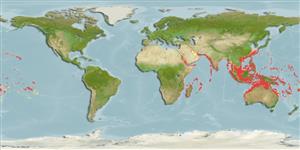分類 / Names
共通名の | 類義語 | Catalog of Fishes(部類, 種) | ITIS | CoL | WoRMS | Cloffa
Environment: milieu / climate zone / depth range / distribution range
生態学
海 関連する礁; 海洋回遊性 (Ref. 51243); 深さの範囲 1 - 300 m (Ref. 28016). Subtropical; 30°N - 32°S, 29°E - 123°W (Ref. 5222)
Indo-Pacific: Red Sea to South Africa and eastward to Ducie in the Pitcairn Group, north to Japan, south to New South Wales and Lord Howe Island. Migration report from the eastern Mediterranean Sea (Ref. 6489, 5385) may be based on Epinephelus coioides specimens.
Length at first maturity / サイズ / 重さ / 年齢
Maturity: Lm 61.1, range 61 - ? cm
Max length : 100.0 cm TL オス/雌雄の選別がない; (Ref. 89972); common length : 90.0 cm TL オス/雌雄の選別がない; (Ref. 5450)
背面の脊椎 (合計): 11; 背鰭 (合計): 13-16; 肛門の骨 3; 臀鰭: 8. Color of head and body pale greenish grey or brown with round dark spots that vary from dull orange-red to dark brown, centers darker than the edges. A large black blotch (or group of black spots) often visible on body at the base of last 4 dorsal-fin spines. Five sub vertical dark bars may be present on body. Dark spots on soft dorsal, caudal and anal fins of juveniles are so close that the pale interspaces form a white reticulum. 95-112 scales in longitudinal series. Scales on body ctenoid in juveniles, becoming cycloid in adults except the area beneath and posterior to pectoral fins. Pyloric caeca 16-18. Further characterized by: elongate body, depth contained 3.0-3.6 times in SL; large head, length is 2.1-2.4 times in SL; snout length 2.0-2.4 times in upper-jaw length; interorbital area narrow, flat to slightly concave, interorbital width 6.8-8.1 times in HL and 3.1-4.0 times in upper jaw length; broadly rounded preopercle, serrae at angle of preopercle slightly enlarged; upper edge of operculum almost straight; posterior nostrils distinctly larger than anterior nostrils; maxilla reaching well past eye, greatest width about twice suborbital depth, maxilla width 6.8-8.1% of standard length; upper-jaw length 21-24% of SL; 2-5 rows of teeth on midlateral part of lower jaw; inner teeth at symphysis of upper jaw are longer than the fixed canines at front of jaw (Ref. 89707). Differs from E. howlandi by its more elongate body and closer-set spots (Ref. 37816).
Adults prefer clear water areas on coral reefs; juveniles have been taken from reef flats and in tide pools, adults found in deeper waters. Solitary and common in lightly fished areas (Ref. 37816). Adults from Oceania almost exclusively feed on fishes (holocentrids, mullid, and pomacentrid); and occasionally, crustaceans (Ref. 89707). Present in the Hong Kong live fish markets (Ref. 27253). Minimum depth reported taken from Ref. 30874. Occasionally ciguatoxic (Ref. 37816). Reports of sizes in excess of 80 cm total length for E. tauvina are probably based on misidentifications of E. coioides, E. malabaricus, and E. lanceolatus; these species grow much bigger than E. tauvina (Ref. 5222, Heemstra pers. comm. 09/04).
.
Life cycle and mating behavior
成熟 | 繁殖 | 放精 | 卵 | 生産力 | 幼生
Heemstra, P.C. and J.E. Randall, 1993. FAO Species Catalogue. Vol. 16. Groupers of the world (family Serranidae, subfamily Epinephelinae). An annotated and illustrated catalogue of the grouper, rockcod, hind, coral grouper and lyretail species known to date. Rome: FAO. FAO Fish. Synop. 125(16):382 p. (Ref. 5222)
人間に対する脅威
Reports of ciguatera poisoning (Ref. 9710)
Human uses
水産業: 少数商業の; 水産養殖: 商業; ゲームフィッシュ: はい
用具
特記事項
XMLをダウンロードして下さい
インターネットの情報源
Estimates based on models
Preferred temperature (Ref.
123201): 19.6 - 28.2, mean 26.2 °C (based on 1115 cells).
Phylogenetic diversity index (Ref.
82804): PD
50 = 0.5000 [Uniqueness, from 0.5 = low to 2.0 = high].
Bayesian length-weight: a=0.01202 (0.01042 - 0.01387), b=3.04 (3.01 - 3.07), in cm total length, based on LWR estimates for this species (Ref.
93245).
栄養段階 (Ref.
69278): 4.1 ±0.68 se; based on food items.
回復力 (Ref.
120179): 低い, 4.5年~14年の倍増期間の最小個体群 (K=0.1-0.17; tm=5-6; Fec = 354,989).
Fishing Vulnerability (Ref.
59153): High vulnerability (59 of 100).
Climate Vulnerability (Ref.
125649): Very high vulnerability (78 of 100).
Nutrients (Ref.
124155): Calcium = 11.8 [4.7, 25.6] mg/100g; Iron = 0.477 [0.234, 1.002] mg/100g; Protein = 19.2 [17.5, 20.7] %; Omega3 = 0.195 [0.108, 0.367] g/100g; Selenium = 25.5 [12.4, 56.4] μg/100g; VitaminA = 117 [27, 467] μg/100g; Zinc = 0.625 [0.409, 0.950] mg/100g (wet weight); based on
nutrient studies.
